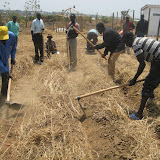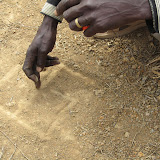Here are the highlights for Diantha from the week:
Sunday at Yei Church (see photo): Phyllis Hankins has been teaching people to bring offerings of food from their garden if they don’t have money, to help support the pastors and teachers for the church’s schools (who are all virtually unpaid). People are now starting to respond. Saturday at Diantha’s health workshop for 43 United Methodist women, we gave them each 8 bars of soap, sold in a row, and suggested they could give one bar each to the church and the school. Sunday, one of the women who had attended this workshop brought a big tub of her peanuts and a dozen ears of dried maize wrapped in a hand embroidered cloth. After church the pastor auctioned it off (which was a lively scene) for about 4 times their value. Apparently other churches do this as well. The only way the church’s schools here can pay their teachers is to charge school fees, and the people in the rural villages are subsistence farmers, without much cash. Money was donated so each school has a blackboard and chalk. They have little else (no books, etc.). Their determination is inspiring.
Monday we had a chance to visit another health clinic, this one run by the Evangelical Presbyterian Church with German doctors. It is a secondary health center, and has one of the few dentists here. They are building a unit to house about 15 more patients overnight (they already have 4 beds.) The private clinics are very well run.
Bishop Wandabula is our bishop from East Annual Conference (which includes 5 countries: Sudan, Kenya, Uganda, Rwanda and Burundi!), and he is based in Kampala Uganda. He came for a visit this week. It was very successful. The church at Yei held a great reception, with the children singing and processing. He was very supportive of the difficult work that Boo and Phyllis have been doing, of our proposed work, and also held a meeting with the local pastors where he answered their concerns point by point, firmly backing up Boo as the District Superintendent (see photos). Friday we traveled 26 miles to Lasu near the Congo border which houses 9,000 Congolese refugees for ribbon cutting celebration. United Methodist Committee on Relief (UMCOR), the UN High Commission on Refugees, and other NGO’s had built several school buildings, latrines, drilled wells, and updated the government health center. Now it is the best equipped health center (many sit without money for staff or medicines), and includes a midwife and birthing center. They said the original water holes were shared with gorillas. That’s the closest we’ve come to wild animals here besides the tropical gecko that lurks outside our bathroom window snapping up mosquitos. On the way to Lasu we stopped in to see 2 very isolated Methodist churches. Mama Kamisa at Gwiria was so excited to see the Bishop and wanted us to come to her house up on the hill. She has helped start 4 churches, and is about 70 years old and very lively. She is raising her arms in joy in the photo. We also had a blessing of the bore hole which was made possible by Holston Conference offerings. Twenty six miles does not seem like much in the US. Here however, it is not an easy trip. It took over 2 hours in the land cruiser in a very lurching ride. There are places which have become impassible where people have made a little detour side road. A torrential downpour began just before we left, so parts of the road were like a river, (see photo) totally covered in water and Boo who was driving couldn’t tell where the ruts were. A few times the wake from the water splashed on the hood of the land cruiser (it is made to drive through water). We made it back safely, but very tired.
Another highlight was Betty receiving her bicycle (see photo). She is about 17 years old, and in the 9th grade (the war or poverty disturbed many students’ education). A Holston Conference church is supporting her high school fees and her food as well. She is already an outstanding leader in her church. When her mother was ill, she took over her position as United Methodist Women’s leader.
We are waiting for the roads to clear up before visiting more rural churches, and in the meantime are visiting some of the other NGO’s here who are doing similar kind of development in the villages, to learn from them and find out what the local resources are.
We really appreciate any little notes you send us, and updates on your lives.
Sunday, September 26, 2010
Subscribe to:
Post Comments (Atom)
















No comments:
Post a Comment